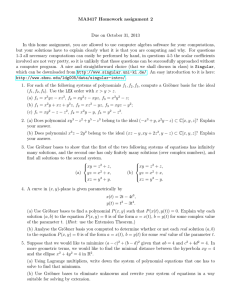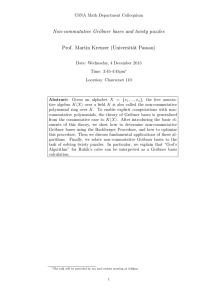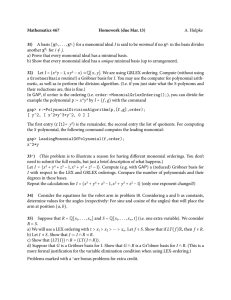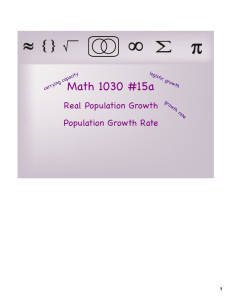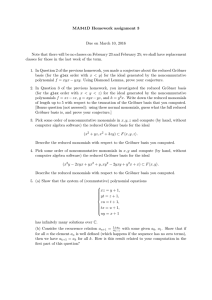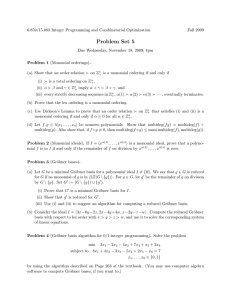Document 13449637
advertisement
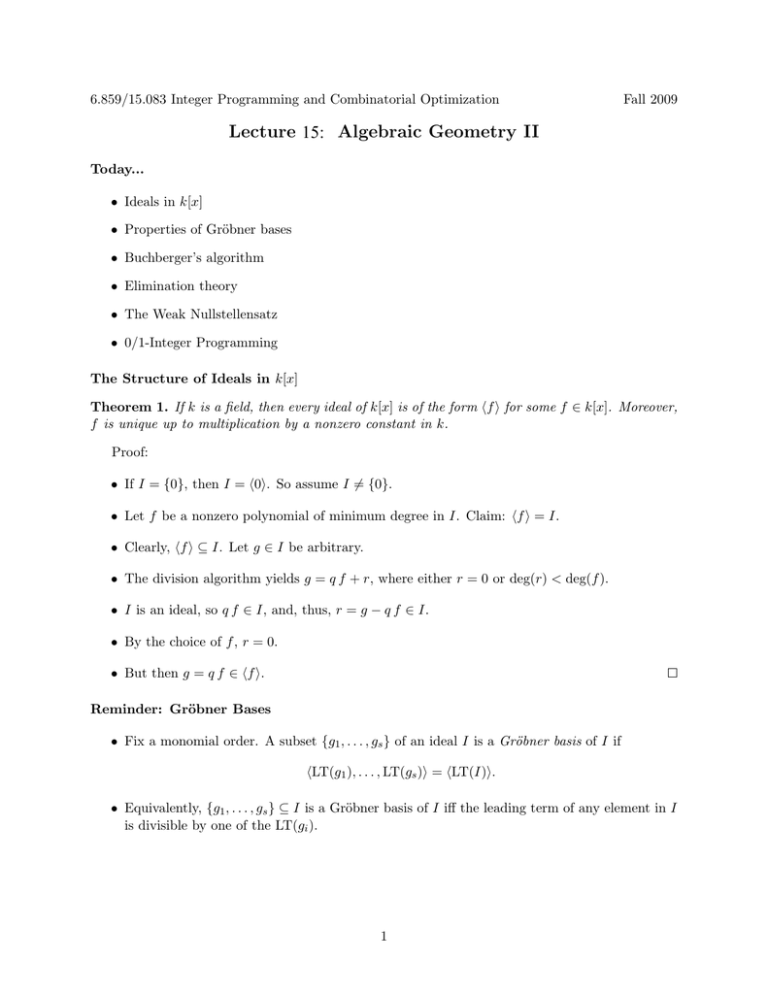
6.859/15.083 Integer Programming and Combinatorial Optimization
Fall 2009
Lecture 15: Algebraic Geometry II
Today...
• Ideals in k[x]
• Properties of Gröbner bases
• Buchberger’s algorithm
• Elimination theory
• The Weak Nullstellensatz
• 0/1-Integer Programming
The Structure of Ideals in k[x]
Theorem 1. If k is a field, then every ideal of k[x] is of the form �f � for some f ∈ k[x]. Moreover,
f is unique up to multiplication by a nonzero constant in k.
Proof:
• If I = {0}, then I = �0�. So assume I �= {0}.
• Let f be a nonzero polynomial of minimum degree in I. Claim: �f � = I.
• Clearly, �f � ⊆ I. Let g ∈ I be arbitrary.
• The division algorithm yields g = q f + r, where either r = 0 or deg(r) < deg(f ).
• I is an ideal, so q f ∈ I, and, thus, r = g − q f ∈ I.
• By the choice of f , r = 0.
• But then g = q f ∈ �f �.
Reminder: Gröbner Bases
• Fix a monomial order. A subset {g1 , . . . , gs } of an ideal I is a Gröbner basis of I if
�LT(g1 ), . . . , LT(gs )� = �LT(I)�.
• Equivalently, {g1 , . . . , gs } ⊆ I is a Gröbner basis of I iff the leading term of any element in I
is divisible by one of the LT(gi ).
1
Properties of Gröbner Bases I
Theorem 2. Let G = {g1 , . . . , gs } be a Gröbner basis for an ideal I, and let f ∈ k[x1 , . . . , xn ].
Then the remainder r on division of f by G is unique, no matter how the elements of G are listed
when using the division algorithm.
Proof:
• First, recall the following result: Let I = �xα : α ∈ A� be a monomial ideal. Then a monomial
xβ lies in I iff xβ is divisible by xα for some α ∈ A.
• Suppose f = a1 g1 +· · · + as gs + r = a�1 g1 + · · · + a�s gs + r� with r �= r� .
• Then r − r� ∈ I and, thus, LT(r − r� ) ∈ �LT(I)� = �LT(g1 ), . . . , LT(gs )�.
• The lemma implies that LT(r − r� ) is divisible by one of LT(g1 ), . . . , LT(gs ).
• This is impossible since no term of r, r� is divisible by one of LT(g1 ), . . . , LT(gs ).
S-Polynomials
• Let I = �f1 , . . . , ft �.
• We show that, in general, �LT(I)� can be strictly larger than �LT(f1 ), . . . , LT(ft )�.
• Consider I = �f1 , f2 �, where f1 = x3 − 2xy and f2 = x2 y − 2y 2 + x with grlex order.
• Note that
x · (x2 y − 2y 2 + x) − y ·
(x3 − 2xy) = x2 ,
so x2 ∈ I. Thus x2 = LT(x2 ) ∈ �LT(I)�.
• However, x2 is not divisible by LT(f1 ) = x3 or LT(f2 ) = x2 y, so that x2 �∈ �LT(f1 ), LT(f2 )�.
• What happened?
• The leading terms in a suitable combination
axα fi − bxβ fj
may cancel, leaving only smaller terms.
• On the other hand, axα fi − bxβ fj ∈ I, so its leading term is in �LT(I)�.
• This is an “obstruction” to {f1 , . . . , ft } being a Gröbner basis.
• Let f, g ∈ k[x1 , . . . , xn ] be nonzero polynomials with multideg(f ) = α and multideg(g) = β.
• Let γi = max(αi , βi ). We call xγ the least common multiple of LM(f ) and LM(g).
• The S-polynomial of f and g is defined as
S(f, g) =
xγ
xγ
·f −
· g.
LT(f )
LT(g)
2
• An S-polynomial is designed to produce cancellation of leading terms.
Example:
• Let f = x3 y 2 − x2 y 3 + x and g = 3x4 y + y 2 with the grlex order.
• Then γ = (4, 2).
• Moreover,
x4y 2
x4 y 2
·
f
−
·g
x3 y 2
3x4 y
1
=x·f − y·g
3
1
= −x3 y 3 + x2 − y 3
3
S(f, g) =
• Consider
�t
i=1 ci fi ,
where ci ∈ k and multideg(fi ) = δ ∈ Zn+ for all i.
�
�
• If multideg( ti=1 ci fi ) < δ, then ti=1 ci fi is a linear combination, with coefficients in k, of
the S-polynomials S(fj , fk ) for 1 ≤ j, k ≤ t.
• Moreover, each S(fj , fk ) has multidegree < δ.
t
�
ci fi =
�
i=1
cjk S(fj , fk )
j,k
Properties of Gröbner Bases II
Theorem 3. A basis G = {g1 , . . . , gs } for an ideal I is a Gröbner basis iff for all pairs i �= j, the
remainder on division of S(gi , gj ) by G is zero.
Sketch of proof:
• Let f ∈ I be a nonzero polynomial. There are polynomials hi such that f =
�s
i=1 hi gi .
• It follows that multideg(f ) ≤ max(multideg(hi gi )).
• If “<”, then some cancellation of leading terms must occur.
• These can be rewritten as S-polynomials.
• The assumption allows us to replace S-polynomials by expressions that involve less cancella­
tion.
• We eventually find an expression for f such that multideg(f ) = multideg(hi gi ) for some i.
• It follows that LT(f ) is divisible by LT(gi ).
• This shows that LT(f ) ∈ �LT(g1 ), . . . , LT(gs )�.
3
Buchberger’s Algorithm
• Consider I = �f1 , f2 �, where f1 = x3 − 2xy and f2 = x2 y − 2y 2 + x with grlex order. Let
F = (f1 , f2 ).
• S(f1 , f2 ) = −x2 ; its remainder on division by F is −x2 .
• Add f3 = −x2 to the generating set F .
• S(f1 , f3 ) = −2xy; its remainder on division by F is −2xy.
• Add f4 = −2xy to the generating set F .
• S(f1 , f4 ) = −2xy 2 ; its remainder on division by F is 0.
• S(f2 , f3 ) = −2y 2 + x; its remainder is −2y 2 + x.
• Add f5 = −2y 2 + x to the generating set F .
• The resulting set F satisfies the “S-pair criterion,” so it is a Gröbner basis.
Buchberger’s Algorithm
The algorithm:
{defining I = �f1 , . . . , ft �}
In: F = (f1 , . . . , ft )
Out: Gröbner basis G = (g1 , . . . , gs ) for I, with F ⊆ G
1. G := F
2. REPEAT
3.
G� := G
4. FOR each pair p =
� q in G� DO
5.
S := remainder of S(p, q) on division by G�
6.
IF S �= 0 THEN G := G ∪ {S}
7. UNTIL G = G�
Buchberger’s Algorithm
Proof of correctness:
• The algorithm terminates when G = G� , which means that G satisfies the S-pair criterion.
Proof of finiteness:
• The ideals �LT(G� )� from successive iterations form an ascending chain.
4
• Let us call this chain J1 ⊂ J2 ⊂ J3 ⊂ · · · .
• Their union J = ∪∞
i=1 Ji is an ideal as well. By Hilbert’s Basis Theorem, it is finitely generated:
J = �h1 , . . . , hr �.
• Each of the h� is contained in one of the Ji . Let N be the maximum such index i.
• Then J = �h1 , . . . , hr � ⊆ JN ⊂ JN +1 ⊂ · · · ⊂ J.
• So the chain stabilizes with JN , and the algorithm terminates after a finite number of steps.
Minimal Gröbner Basis
• Let G be a Gröbner basis for I, and let p ∈ G be such that LT(p) ∈ �LT(G \ {p})�. Then
G \ {p} is also a Gröbner basis for I.
• A minimal Gröbner basis for an ideal I is a Gröbner basis G for I such that
1. LC(p) = 1 for all p ∈ G.
2. For all p ∈ G, LT(p) �∈ �LT(G \ {p})�.
• A given ideal may have many minimal Gröbner bases. But we can single one out that is
“better” than the others:
• A reduced Gröbner basis for an ideal I is a Gröbner basis G for I such that
1. LC(p) = 1 for all p ∈ G.
2. For all p ∈ G, no monomial of p lies in �LT(G \ {p})�.
Reduced Gröbner Basis
Lemma 4. Let I �= {0} be an ideal. Then, for a given monomial ordering, I has a unique reduced
Gröbner basis.
(One can obtain a reduced Gröbner basis from a minimal one by replacing g ∈ G by the remainder of g on
division by G \ {g}, and repeating.)
Elimination Theory
• Systematic methods for eliminating variables from systems of polynomial equations.
• For example, consider
x1 + 2x2 + 3x3 + 4x4 + 5x5 + 15x6 − 15 = 0, x21 − x1 = 0, . . . , x26 − x6 = 0.
• The reduced Gröbner basis with respect to lex order is G = {x26 − x6 , x5 + x6 − 1, x4 + x6 −
1, x3 + x6 − 1, x2 + x6 − 1, x1 + x6 − 1}.
• So the original system has exactly two solutions: x̄ = (1, 1, 1, 1, 1, 0) or x̄ = (0, 0, 0, 0, 0, 1)
5
• Given I = �f1 , . . . , fs � ⊆ k[x1 , . . . , xn ], the �-th elimination ideal I� is the ideal of k[x�+1 , . . . , xn ]
defined by
I� = I ∩ k[x�+1 , . . . , xn ].
• I� consists of all consequences of f1 = f2 = · · · = fs = 0 which eliminate the variables
x1 , . . . , x� .
• Eliminating x1 , . . . , x� means finding nonzero polynomials in I� .
Theorem 5. Let I ⊆ k[x1 , . . . , xn ] be an ideal, and let G be a Gröbner basis of I with respect to
lex order where x1 > x2 > · · · > xn . Then, for every 0 ≤ � ≤ n − 1, the set
G� = G ∩ k[x�+1 , . . . , xn ]
is a Gröbner basis of the �-th elimination ideal I� .
Proof:
• It suffices to show that �LT(I� )� ⊆ �LT(G� )�.
• We show that LT(f ), for f ∈ I� arbitrary, is divisible by LT(g) for some g ∈ G� .
• Note that LT(f ) is divisible by LT(g) for some g ∈ G.
• Since f ∈ I� , this means that LT(g) involves only x�+1 , . . . , xn .
• Any monomial involving x1 , . . . , x� is greater than all monomials in k[x�+1 , . . . , xn ].
• Hence, LT(g) ∈ k[x�+1 , . . . , xn ] implies g ∈ k[x�+1 , . . . , xn ].
• Therefore, g ∈ G� .
The Weak Nullstellensatz
• Recall that a variety V ⊆ k n can be studied via the ideal
I(V ) = {f ∈ k[x1 , . . . , xn ] : f (x) = 0 for all x ∈ V }.
• This gives a map V −→ I(V ).
• On the other hand, given an ideal I,
V (I) = {x ∈ k n : f (x) = 0 for all f ∈ I}.
is an affine variety, by Hilbert’s Basis Theorem.
• This gives a map I −→ V (I).
• Note that the map “V ” is not one-to-one: for example, V (x) = V (x2 ) = {0}.
• Recall that k is algebraically closed if every nonconstant polynomial in k[x] has a root in k.
6
• Also recall that C is algebraically closed (Fundamental Theorem of Algebra).
• Consider 1, 1 + x2 , and 1 + x2 + x4 in R[x]. They generate different ideals:
I1 = �1� = R[x],
I2 = �1 + x2 �,
I3 = �1 + x2 + x4 �.
However, V (I1 ) = V (I2 ) = V (I3 ) = ∅.
• This problem goes away in the one-variable case if k is algebraically closed:
• Let I be an ideal in k[x], where k is algebraically closed.
• Then I = �f �, and V (I) are the roots of f .
• Since every nonconstant polynomial has a root, V (I) = ∅ implies that f is a nonzero constant.
• Hence, 1/f ∈ k. Thus, 1 = (1/f ) · f ∈ I.
• Consequently, g · 1 = g ∈ I for all g ∈ k[x].
• It follows that I = k[x] is the only ideal of k[x] that represents the empty variety when k is
algebraically closed.
• The same holds when there is more than one variable!
Theorem 6. Let k be an algebraically closed field, and let I ⊆ k[x1 , . . . , xn ] be an ideal satisfying
V (I) = ∅. Then I = k[x1 , . . . , xn ].
(Can be thought of as the “Fundamental Theorem of Algebra for Multivariate Polynomials:” every system of
polynomials that generates an ideal smaller than C[x1 , . . . , xn ] has a common zero in Cn .)
• The system
f1 = 0, f2 = 0, . . . , fs = 0
does not have a common solution in Cn iff V (f1 , . . . , fs ) = ∅.
• By the Weak Nullstellensatz, this happens iff 1 ∈ �f1 , . . . , fs �.
• Regardless of the monomial ordering, {1} is the only reduced Gröbner basis for the ideal �1�.
Proof:
• Let g1 , . . . , gs be a Gröbner basis of I = �1�.
• Thus, 1 ∈ �LT(I)� = �LT(g1 ), . . . , LT(gs )�.
• Hence, 1 is divisible by some LT(gi ), say LT(g1 ).
• So LT(g1 ) is constant.
• Then every other LT(gi ) is a multiple of that constant, so g2 , . . . , gs can be removed from the
Gröbner basis.
• Since LT(g1 ) is constant, g1 itself is constant.
7
0/1-Integer Programming: Feasibility
• Normally,
n
�
aij xj = bi
i = 1, . . . m
j=1
xj ∈ {0, 1}
j = 1, . . . , n
• Equivalently,
fi :=
n
�
aij xj − bi = 0
i = 1, . . . m
gj := x2j − xj = 0
j = 1, . . . , n
j=1
An algorithm:
In: A ∈ Zm×n , b ∈ Zm
Out: a feasible solution x̄ to Ax = b, x ∈ {0, 1}n
1. I := �f1 , . . . , fm , g1 , . . . , gn �
2. Compute a Gröbner basis G of I using lex order
3. IF G = {1} THEN
4.
“infeasible”
5. ELSE
6.
Find x̄n in V (Gn1 )
7.
FOR l = n − 1 TO 1 DO
8.
Extend (x̄l+1 , . . . , x̄n ) to (x̄l , . . . , x̄n ) ∈ V (Gl−1 )
Example:
• Consider
x1 + 2x2 + 3x3 + 4x4 + 5x5 + 15x6 = 15
x1 , x2 , . . . , x6 ∈ {0, 1}
• The reduced Gröbner basis is G = {x26 − x6 , x5 + x6 − 1, x4 + x6 − 1, x3 + x6 − 1, x2 + x6 −
1, x1 + x6 − 1}
• G5 = {x26 − x6 }, so x̄6 = 0 and x̄6 = 1 are possible solutions
• We get x̄ = (1, 1, 1, 1, 1, 0) or x̄ = (0, 0, 0, 0, 0, 1)
8
Structural insights:
• The polynomials in the reduced Gröbner basis can be partitioned into n sets:
– Sn contains only one polynomial, which is either xn , xn − 1, or x2n − xn .
– Si , for 1 ≤ i ≤ n − 1, contains polynomials in xn , . . . , xi .
• Similar to row echelon form in Gaussian elimination.
• Allows solving the system variable by variable.
Example:
• Consider
x1 + 2x2 + 3x3 + 4x4 + 6x5 = 6,
x1 , . . . , x5 ∈ {0.1}
• The reduced Gröbner basis is
� 2
�
x5 − x5 , x4 x5 , x24 − x4 , x3 + x4 + x5 − 1, x2 + x5 − 1, x1 + x4 + x5 − 1
•
The sets are
S5 = {x25 − x5 }
S4 = {x4 x5 , x24 − x4 }
S3 = {x3 + x4 + x5 − 1}
S2 = {x2 + x5 − 1}
S1 = {x1 + x4 + x5 − 1}
0/1-Integer Programming: Optimization
Modify the algorithm as follows:
�
• Let h = y − nj =1 cj xj .
• Consider k[x1 , . . . , xn , y] and V (f1 , . . . , fm , g1 , . . . , gm , h).
• Use lex order with x1 > · · · > xn > y.
• The reduced Gröbner basis is either {1} or its intersection with k[y] is a polynomial in y.
• Every root of this polynomial is an objective function value that can be feasibly attained.
• Find the minimum root, and work backwards to get the associated values of xn , . . . , x1 .
Example:
�
�
• min x1 + 2x2 + 3x3 : x1 + 2x2 + 2x3 = 3, x1 , . . . , x3 ∈ {0, 1} .
• The reduced Gröbner basis is
�
�
12 − 7y + y 2 , 3 + x3 − y, −4 + x2 + y, 1 − x1 .
• The two roots of 12 − 7y + y 2 are 3 and 4.
• The minimum value is y = 3, and the corresponding solution is (1, 1, 0).
9
MIT OpenCourseWare
http://ocw.mit.edu
15.083J / 6.859J Integer Programming and Combinatorial Optimization
Fall 2009
For information about citing these materials or our Terms of Use, visit: http://ocw.mit.edu/terms.
